MPE781 Economics: Analyzing the Impact of Online Shopping Tax
VerifiedAdded on 2023/06/08
|16
|3456
|132
Case Study
AI Summary
This case study examines the economic implications of the online shopping tax implemented in Australia, focusing on its effects on consumers, retailers, and overall market efficiency. The analysis begins with a summary of an article discussing Amazon's response to the tax by redirecting Australian shoppers to its local website, which offers limited goods at higher prices. The study uses economic theories and concepts, including demand and supply analysis, to evaluate the impact of the tax on market prices, equilibrium quantities, and consumer welfare. It argues that the tax punishes Australian consumers by reducing choice and increasing prices, potentially leading to a deadweight loss and reduced competitive efficiency among domestic retailers. The study further explores the rationale for online shopping platforms, highlighting their advantages in terms of variety, convenience, and price comparison. Ultimately, the case study concludes that the online tax fails to enhance the competitive efficiency of Australian retailers and may instead lead to market capitulation by larger retailers due to existing cost burdens and regulatory issues.

Running Head: ECONOMICS FOR MANAGERS
Economics for Managers
Name of the Student
Name of the University
Course ID
Student ID
Economics for Managers
Name of the Student
Name of the University
Course ID
Student ID
Paraphrase This Document
Need a fresh take? Get an instant paraphrase of this document with our AI Paraphraser
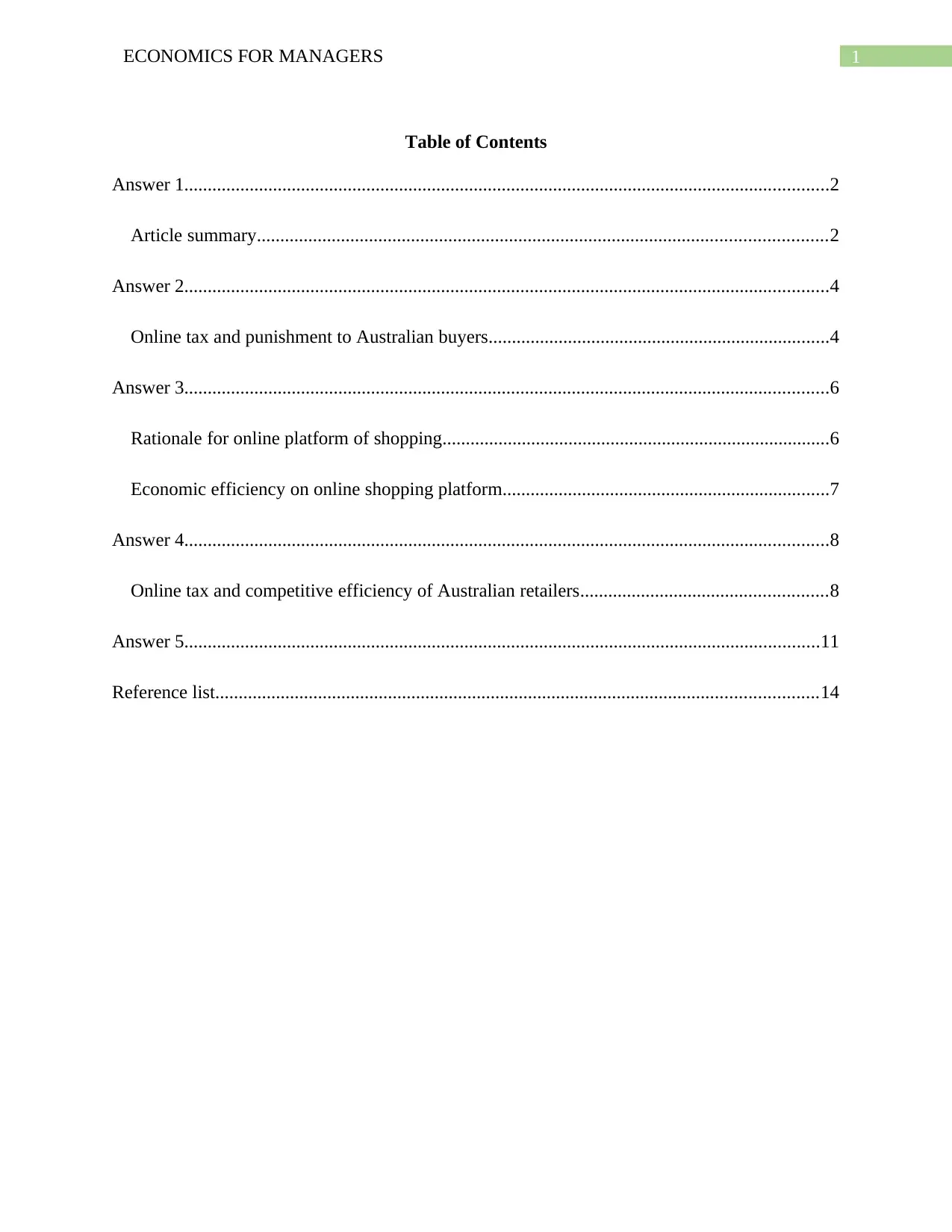
1ECONOMICS FOR MANAGERS
Table of Contents
Answer 1..........................................................................................................................................2
Article summary..........................................................................................................................2
Answer 2..........................................................................................................................................4
Online tax and punishment to Australian buyers.........................................................................4
Answer 3..........................................................................................................................................6
Rationale for online platform of shopping...................................................................................6
Economic efficiency on online shopping platform......................................................................7
Answer 4..........................................................................................................................................8
Online tax and competitive efficiency of Australian retailers.....................................................8
Answer 5........................................................................................................................................11
Reference list.................................................................................................................................14
Table of Contents
Answer 1..........................................................................................................................................2
Article summary..........................................................................................................................2
Answer 2..........................................................................................................................................4
Online tax and punishment to Australian buyers.........................................................................4
Answer 3..........................................................................................................................................6
Rationale for online platform of shopping...................................................................................6
Economic efficiency on online shopping platform......................................................................7
Answer 4..........................................................................................................................................8
Online tax and competitive efficiency of Australian retailers.....................................................8
Answer 5........................................................................................................................................11
Reference list.................................................................................................................................14
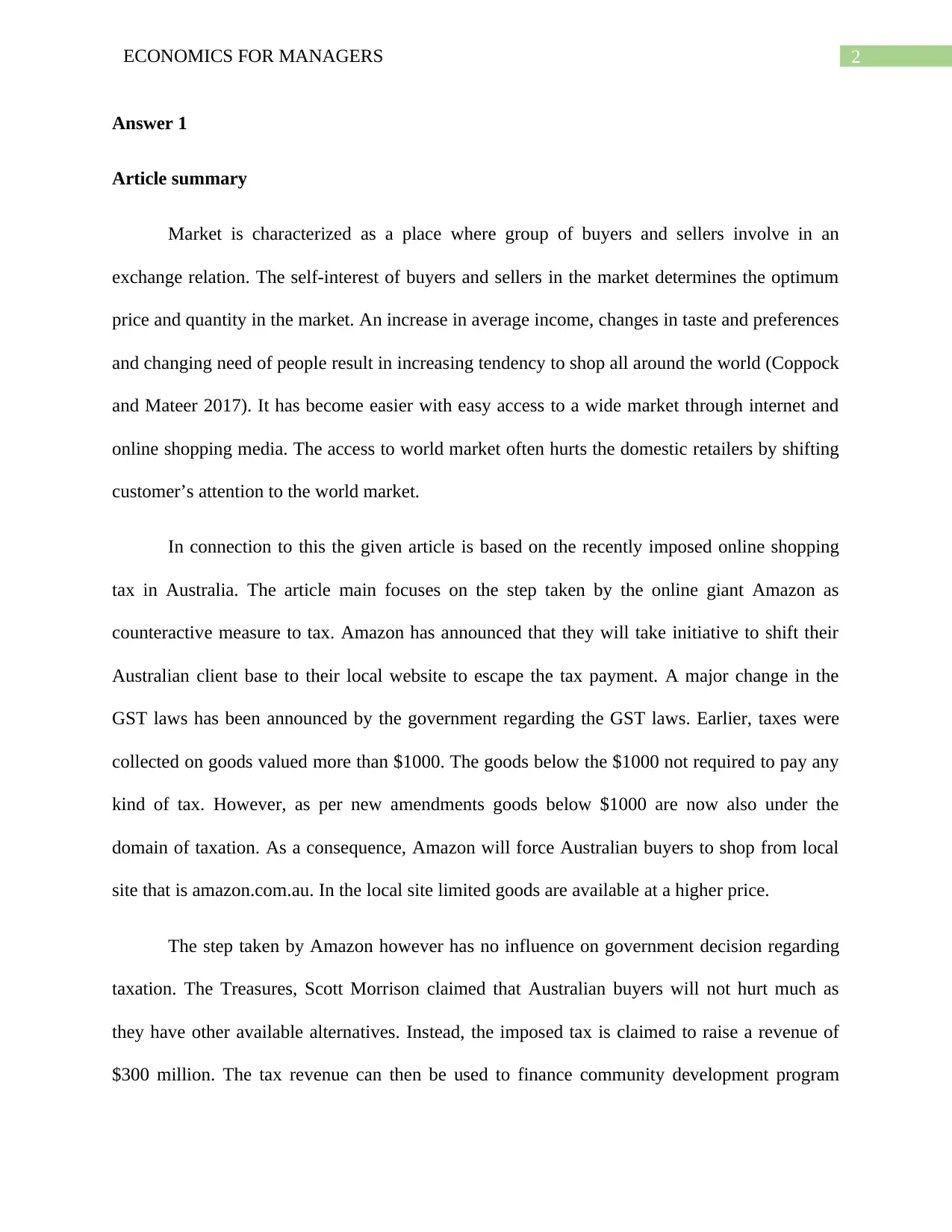
2ECONOMICS FOR MANAGERS
Answer 1
Article summary
Market is characterized as a place where group of buyers and sellers involve in an
exchange relation. The self-interest of buyers and sellers in the market determines the optimum
price and quantity in the market. An increase in average income, changes in taste and preferences
and changing need of people result in increasing tendency to shop all around the world (Coppock
and Mateer 2017). It has become easier with easy access to a wide market through internet and
online shopping media. The access to world market often hurts the domestic retailers by shifting
customer’s attention to the world market.
In connection to this the given article is based on the recently imposed online shopping
tax in Australia. The article main focuses on the step taken by the online giant Amazon as
counteractive measure to tax. Amazon has announced that they will take initiative to shift their
Australian client base to their local website to escape the tax payment. A major change in the
GST laws has been announced by the government regarding the GST laws. Earlier, taxes were
collected on goods valued more than $1000. The goods below the $1000 not required to pay any
kind of tax. However, as per new amendments goods below $1000 are now also under the
domain of taxation. As a consequence, Amazon will force Australian buyers to shop from local
site that is amazon.com.au. In the local site limited goods are available at a higher price.
The step taken by Amazon however has no influence on government decision regarding
taxation. The Treasures, Scott Morrison claimed that Australian buyers will not hurt much as
they have other available alternatives. Instead, the imposed tax is claimed to raise a revenue of
$300 million. The tax revenue can then be used to finance community development program
Answer 1
Article summary
Market is characterized as a place where group of buyers and sellers involve in an
exchange relation. The self-interest of buyers and sellers in the market determines the optimum
price and quantity in the market. An increase in average income, changes in taste and preferences
and changing need of people result in increasing tendency to shop all around the world (Coppock
and Mateer 2017). It has become easier with easy access to a wide market through internet and
online shopping media. The access to world market often hurts the domestic retailers by shifting
customer’s attention to the world market.
In connection to this the given article is based on the recently imposed online shopping
tax in Australia. The article main focuses on the step taken by the online giant Amazon as
counteractive measure to tax. Amazon has announced that they will take initiative to shift their
Australian client base to their local website to escape the tax payment. A major change in the
GST laws has been announced by the government regarding the GST laws. Earlier, taxes were
collected on goods valued more than $1000. The goods below the $1000 not required to pay any
kind of tax. However, as per new amendments goods below $1000 are now also under the
domain of taxation. As a consequence, Amazon will force Australian buyers to shop from local
site that is amazon.com.au. In the local site limited goods are available at a higher price.
The step taken by Amazon however has no influence on government decision regarding
taxation. The Treasures, Scott Morrison claimed that Australian buyers will not hurt much as
they have other available alternatives. Instead, the imposed tax is claimed to raise a revenue of
$300 million. The tax revenue can then be used to finance community development program
⊘ This is a preview!⊘
Do you want full access?
Subscribe today to unlock all pages.

Trusted by 1+ million students worldwide
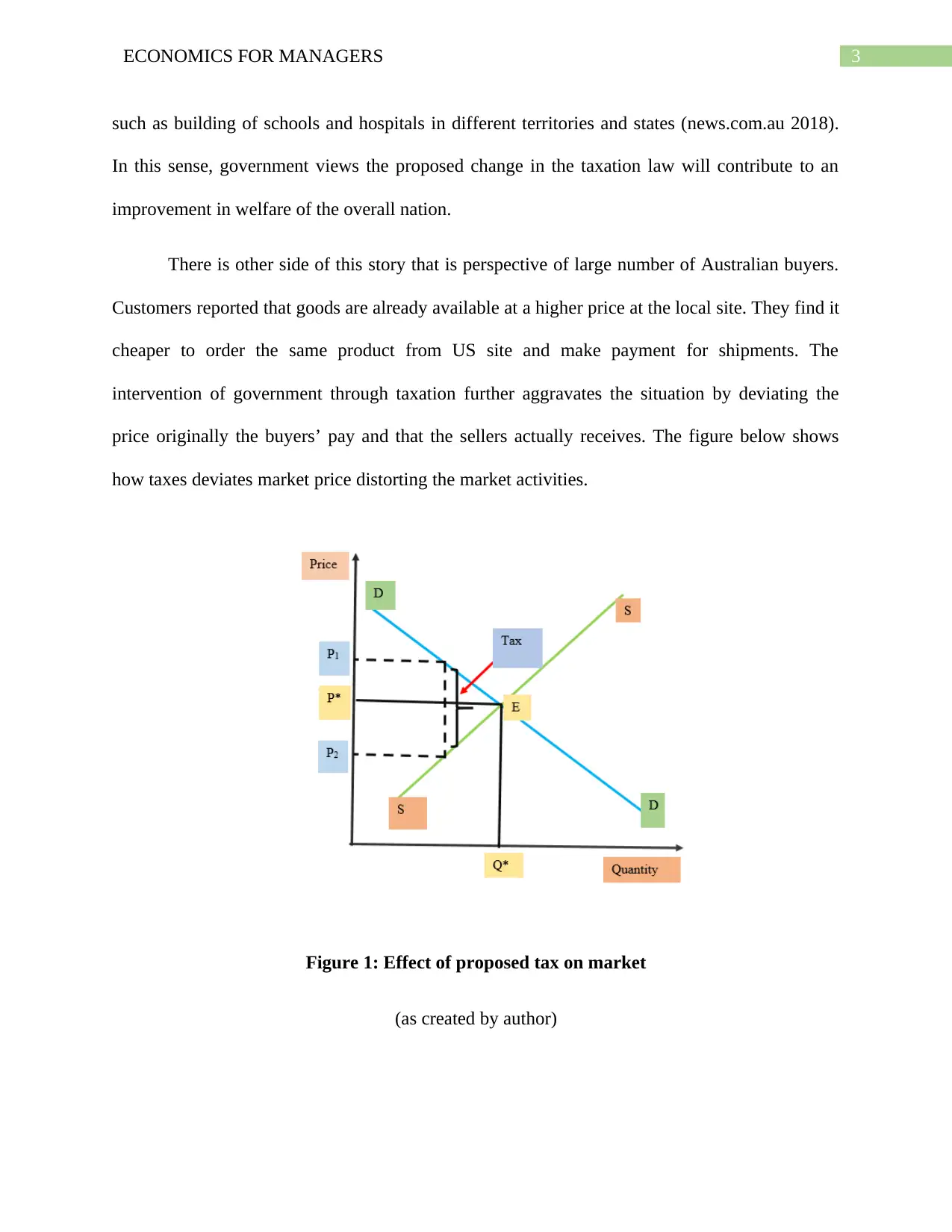
3ECONOMICS FOR MANAGERS
such as building of schools and hospitals in different territories and states (news.com.au 2018).
In this sense, government views the proposed change in the taxation law will contribute to an
improvement in welfare of the overall nation.
There is other side of this story that is perspective of large number of Australian buyers.
Customers reported that goods are already available at a higher price at the local site. They find it
cheaper to order the same product from US site and make payment for shipments. The
intervention of government through taxation further aggravates the situation by deviating the
price originally the buyers’ pay and that the sellers actually receives. The figure below shows
how taxes deviates market price distorting the market activities.
Figure 1: Effect of proposed tax on market
(as created by author)
such as building of schools and hospitals in different territories and states (news.com.au 2018).
In this sense, government views the proposed change in the taxation law will contribute to an
improvement in welfare of the overall nation.
There is other side of this story that is perspective of large number of Australian buyers.
Customers reported that goods are already available at a higher price at the local site. They find it
cheaper to order the same product from US site and make payment for shipments. The
intervention of government through taxation further aggravates the situation by deviating the
price originally the buyers’ pay and that the sellers actually receives. The figure below shows
how taxes deviates market price distorting the market activities.
Figure 1: Effect of proposed tax on market
(as created by author)
Paraphrase This Document
Need a fresh take? Get an instant paraphrase of this document with our AI Paraphraser

4ECONOMICS FOR MANAGERS
Any proposed tax increase the price actually paid by the buyers while lowers the price
that sellers receives. There is a resulting welfare loss termed as dead-weight loss following the
proposed tax (Baumol and Blinder 2015).
There is chances that other online retailers follow the same strategy and exit Australian
market. The taxation thus can be proved a complete failure as it neither increases government
revenue nor increases competitive efficiency of local retailers.
Answer 2
Online tax and punishment to Australian buyers
The new tax amendment has an undesirable stimulus on welfare of customers. The two
most important aspect of customers’ welfare is plenty of choice and price Customers are in
advantageous position when they have a wide variety of goods available at a lower price (Moulin
2014). Both are at a stake after the imposition of tax. In the local website of Amazon customers
face a higher price along with limited choice.
The new tax law mandate tax payment for goods priced below $1000 instead of tax paid
for only goods above $1000 earlier. This disrupts the transaction in the online platform as
Amazon and other retailer prefers to block Australian buyers to their global market instead of
paying the tax. As the online retailers are expected to quit the Australian market this reduces the
available choices to buyers in Australia (sbs.com.au 2018). The reduced competition from the
international market can provide local seller a competitive edge and significant market power.
Exploiting the market power, they can charge a higher price to the local market. The immediate
effect of taxation can be understood from the impact of tax on demand, supply, equilibrium
Any proposed tax increase the price actually paid by the buyers while lowers the price
that sellers receives. There is a resulting welfare loss termed as dead-weight loss following the
proposed tax (Baumol and Blinder 2015).
There is chances that other online retailers follow the same strategy and exit Australian
market. The taxation thus can be proved a complete failure as it neither increases government
revenue nor increases competitive efficiency of local retailers.
Answer 2
Online tax and punishment to Australian buyers
The new tax amendment has an undesirable stimulus on welfare of customers. The two
most important aspect of customers’ welfare is plenty of choice and price Customers are in
advantageous position when they have a wide variety of goods available at a lower price (Moulin
2014). Both are at a stake after the imposition of tax. In the local website of Amazon customers
face a higher price along with limited choice.
The new tax law mandate tax payment for goods priced below $1000 instead of tax paid
for only goods above $1000 earlier. This disrupts the transaction in the online platform as
Amazon and other retailer prefers to block Australian buyers to their global market instead of
paying the tax. As the online retailers are expected to quit the Australian market this reduces the
available choices to buyers in Australia (sbs.com.au 2018). The reduced competition from the
international market can provide local seller a competitive edge and significant market power.
Exploiting the market power, they can charge a higher price to the local market. The immediate
effect of taxation can be understood from the impact of tax on demand, supply, equilibrium
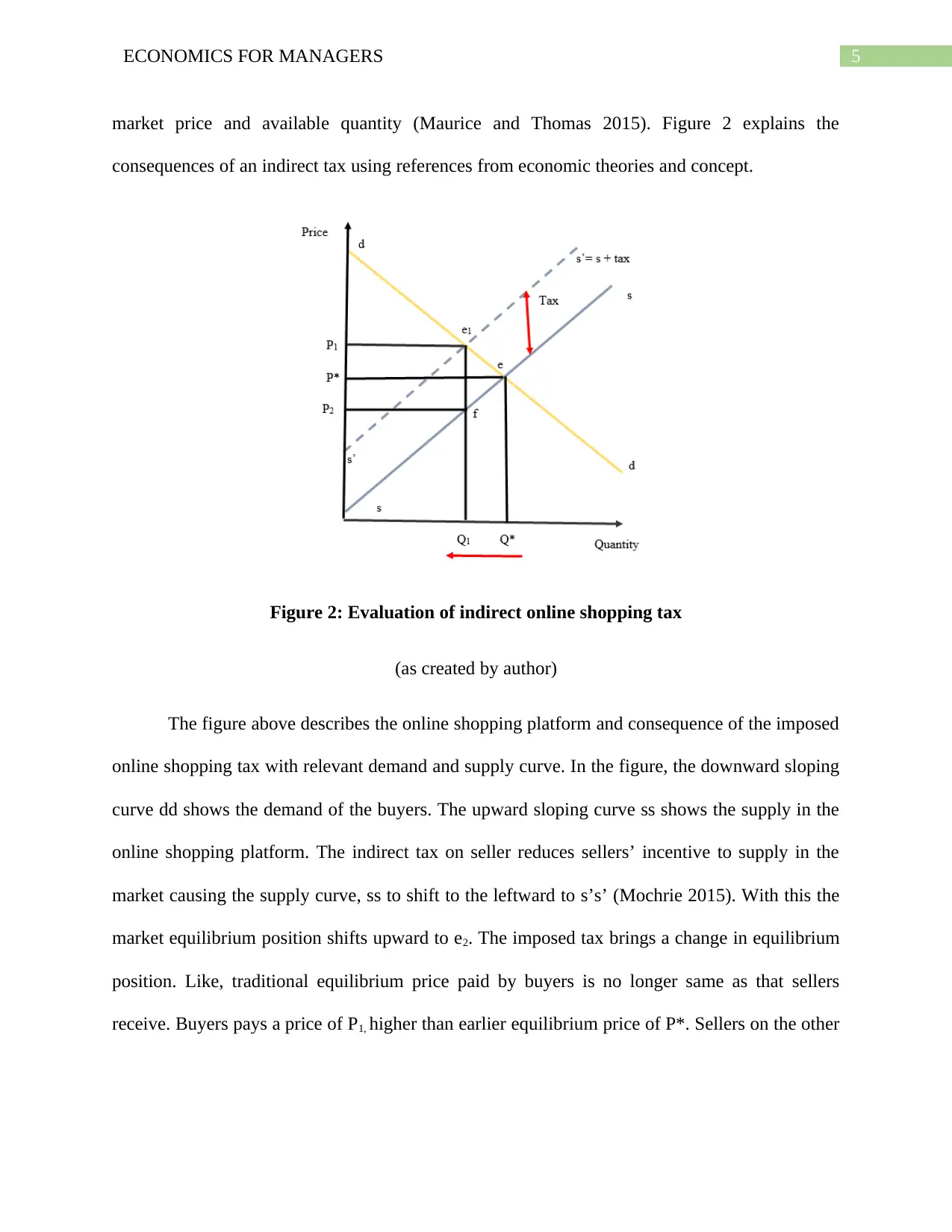
5ECONOMICS FOR MANAGERS
market price and available quantity (Maurice and Thomas 2015). Figure 2 explains the
consequences of an indirect tax using references from economic theories and concept.
Figure 2: Evaluation of indirect online shopping tax
(as created by author)
The figure above describes the online shopping platform and consequence of the imposed
online shopping tax with relevant demand and supply curve. In the figure, the downward sloping
curve dd shows the demand of the buyers. The upward sloping curve ss shows the supply in the
online shopping platform. The indirect tax on seller reduces sellers’ incentive to supply in the
market causing the supply curve, ss to shift to the leftward to s’s’ (Mochrie 2015). With this the
market equilibrium position shifts upward to e2. The imposed tax brings a change in equilibrium
position. Like, traditional equilibrium price paid by buyers is no longer same as that sellers
receive. Buyers pays a price of P1, higher than earlier equilibrium price of P*. Sellers on the other
market price and available quantity (Maurice and Thomas 2015). Figure 2 explains the
consequences of an indirect tax using references from economic theories and concept.
Figure 2: Evaluation of indirect online shopping tax
(as created by author)
The figure above describes the online shopping platform and consequence of the imposed
online shopping tax with relevant demand and supply curve. In the figure, the downward sloping
curve dd shows the demand of the buyers. The upward sloping curve ss shows the supply in the
online shopping platform. The indirect tax on seller reduces sellers’ incentive to supply in the
market causing the supply curve, ss to shift to the leftward to s’s’ (Mochrie 2015). With this the
market equilibrium position shifts upward to e2. The imposed tax brings a change in equilibrium
position. Like, traditional equilibrium price paid by buyers is no longer same as that sellers
receive. Buyers pays a price of P1, higher than earlier equilibrium price of P*. Sellers on the other
⊘ This is a preview!⊘
Do you want full access?
Subscribe today to unlock all pages.

Trusted by 1+ million students worldwide

6ECONOMICS FOR MANAGERS
hand gets a price of P2, lower than the equilibrium price. The difference between P1 and P2 is the
amount of tax. The equilibrium quantity in the market falls from Q* to Q1.
The figure thus explain Australian buyers are at disadvantageous position in terms of
both price and available choices. They face a higher price in the local site. The local sites also
contain less number of the available choice compared to the global sites. At a lower price, buyers
in other nations face a much wider choice (Nicholson and Snyder 2014). Imposition of tax thus
punishes Australian customers by leaving them with a lesser available choice. Restricted visit of
Australian shoppers to the global market denies their ability to shop all across the world.
Answer 3
Rationale for online platform of shopping
The virtual platform of shopping has changed the definition of traditional shopping. The
online platform is beneficial for both buyers and sellers group. Followings are some advantages
that provide online shopping an additional edge over the traditional means of shopping.
Availability of a greater variety
At single place customers are able to access a variety of products belonging to different
brands. Customers on the online platform can get products of latest national and international
brand without need to spend money for travelling. Buyers can purchase particular items from
other part of the country without facing limitation of geographic area (Clemes, Gan and Zhang
2014). The online stores a greater variety of choice related to size, color and brand.
Convenient shopping
hand gets a price of P2, lower than the equilibrium price. The difference between P1 and P2 is the
amount of tax. The equilibrium quantity in the market falls from Q* to Q1.
The figure thus explain Australian buyers are at disadvantageous position in terms of
both price and available choices. They face a higher price in the local site. The local sites also
contain less number of the available choice compared to the global sites. At a lower price, buyers
in other nations face a much wider choice (Nicholson and Snyder 2014). Imposition of tax thus
punishes Australian customers by leaving them with a lesser available choice. Restricted visit of
Australian shoppers to the global market denies their ability to shop all across the world.
Answer 3
Rationale for online platform of shopping
The virtual platform of shopping has changed the definition of traditional shopping. The
online platform is beneficial for both buyers and sellers group. Followings are some advantages
that provide online shopping an additional edge over the traditional means of shopping.
Availability of a greater variety
At single place customers are able to access a variety of products belonging to different
brands. Customers on the online platform can get products of latest national and international
brand without need to spend money for travelling. Buyers can purchase particular items from
other part of the country without facing limitation of geographic area (Clemes, Gan and Zhang
2014). The online stores a greater variety of choice related to size, color and brand.
Convenient shopping
Paraphrase This Document
Need a fresh take? Get an instant paraphrase of this document with our AI Paraphraser
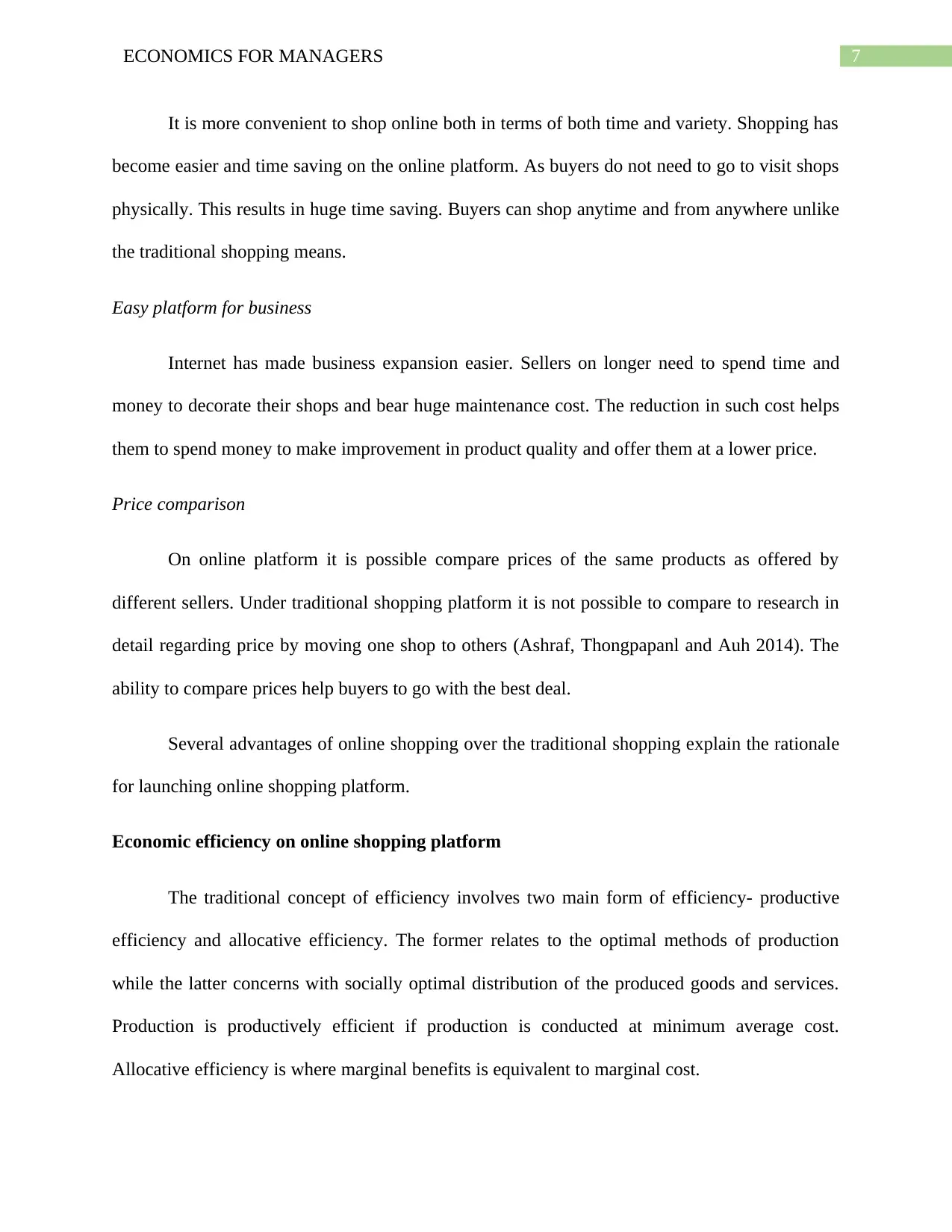
7ECONOMICS FOR MANAGERS
It is more convenient to shop online both in terms of both time and variety. Shopping has
become easier and time saving on the online platform. As buyers do not need to go to visit shops
physically. This results in huge time saving. Buyers can shop anytime and from anywhere unlike
the traditional shopping means.
Easy platform for business
Internet has made business expansion easier. Sellers on longer need to spend time and
money to decorate their shops and bear huge maintenance cost. The reduction in such cost helps
them to spend money to make improvement in product quality and offer them at a lower price.
Price comparison
On online platform it is possible compare prices of the same products as offered by
different sellers. Under traditional shopping platform it is not possible to compare to research in
detail regarding price by moving one shop to others (Ashraf, Thongpapanl and Auh 2014). The
ability to compare prices help buyers to go with the best deal.
Several advantages of online shopping over the traditional shopping explain the rationale
for launching online shopping platform.
Economic efficiency on online shopping platform
The traditional concept of efficiency involves two main form of efficiency- productive
efficiency and allocative efficiency. The former relates to the optimal methods of production
while the latter concerns with socially optimal distribution of the produced goods and services.
Production is productively efficient if production is conducted at minimum average cost.
Allocative efficiency is where marginal benefits is equivalent to marginal cost.
It is more convenient to shop online both in terms of both time and variety. Shopping has
become easier and time saving on the online platform. As buyers do not need to go to visit shops
physically. This results in huge time saving. Buyers can shop anytime and from anywhere unlike
the traditional shopping means.
Easy platform for business
Internet has made business expansion easier. Sellers on longer need to spend time and
money to decorate their shops and bear huge maintenance cost. The reduction in such cost helps
them to spend money to make improvement in product quality and offer them at a lower price.
Price comparison
On online platform it is possible compare prices of the same products as offered by
different sellers. Under traditional shopping platform it is not possible to compare to research in
detail regarding price by moving one shop to others (Ashraf, Thongpapanl and Auh 2014). The
ability to compare prices help buyers to go with the best deal.
Several advantages of online shopping over the traditional shopping explain the rationale
for launching online shopping platform.
Economic efficiency on online shopping platform
The traditional concept of efficiency involves two main form of efficiency- productive
efficiency and allocative efficiency. The former relates to the optimal methods of production
while the latter concerns with socially optimal distribution of the produced goods and services.
Production is productively efficient if production is conducted at minimum average cost.
Allocative efficiency is where marginal benefits is equivalent to marginal cost.
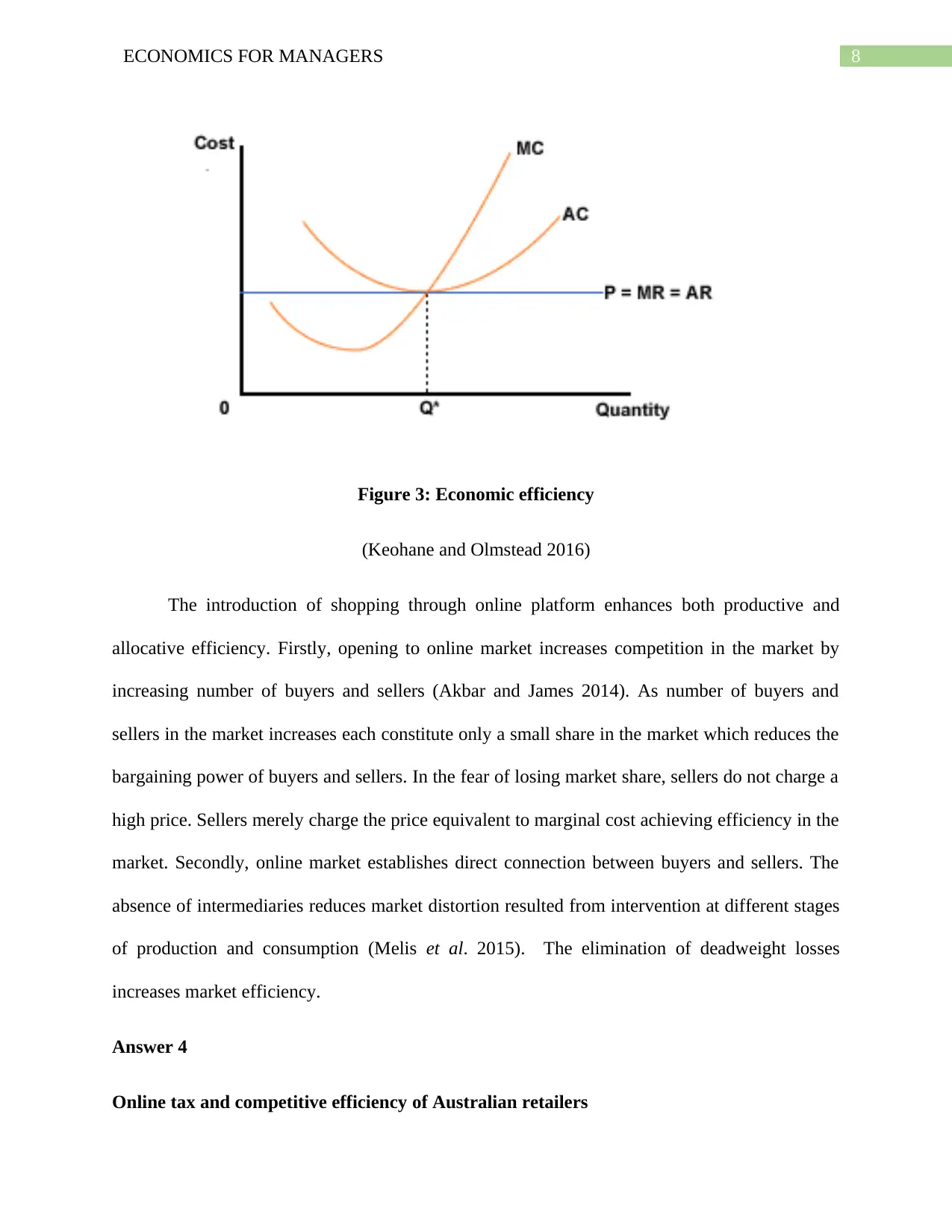
8ECONOMICS FOR MANAGERS
Figure 3: Economic efficiency
(Keohane and Olmstead 2016)
The introduction of shopping through online platform enhances both productive and
allocative efficiency. Firstly, opening to online market increases competition in the market by
increasing number of buyers and sellers (Akbar and James 2014). As number of buyers and
sellers in the market increases each constitute only a small share in the market which reduces the
bargaining power of buyers and sellers. In the fear of losing market share, sellers do not charge a
high price. Sellers merely charge the price equivalent to marginal cost achieving efficiency in the
market. Secondly, online market establishes direct connection between buyers and sellers. The
absence of intermediaries reduces market distortion resulted from intervention at different stages
of production and consumption (Melis et al. 2015). The elimination of deadweight losses
increases market efficiency.
Answer 4
Online tax and competitive efficiency of Australian retailers
Figure 3: Economic efficiency
(Keohane and Olmstead 2016)
The introduction of shopping through online platform enhances both productive and
allocative efficiency. Firstly, opening to online market increases competition in the market by
increasing number of buyers and sellers (Akbar and James 2014). As number of buyers and
sellers in the market increases each constitute only a small share in the market which reduces the
bargaining power of buyers and sellers. In the fear of losing market share, sellers do not charge a
high price. Sellers merely charge the price equivalent to marginal cost achieving efficiency in the
market. Secondly, online market establishes direct connection between buyers and sellers. The
absence of intermediaries reduces market distortion resulted from intervention at different stages
of production and consumption (Melis et al. 2015). The elimination of deadweight losses
increases market efficiency.
Answer 4
Online tax and competitive efficiency of Australian retailers
⊘ This is a preview!⊘
Do you want full access?
Subscribe today to unlock all pages.

Trusted by 1+ million students worldwide
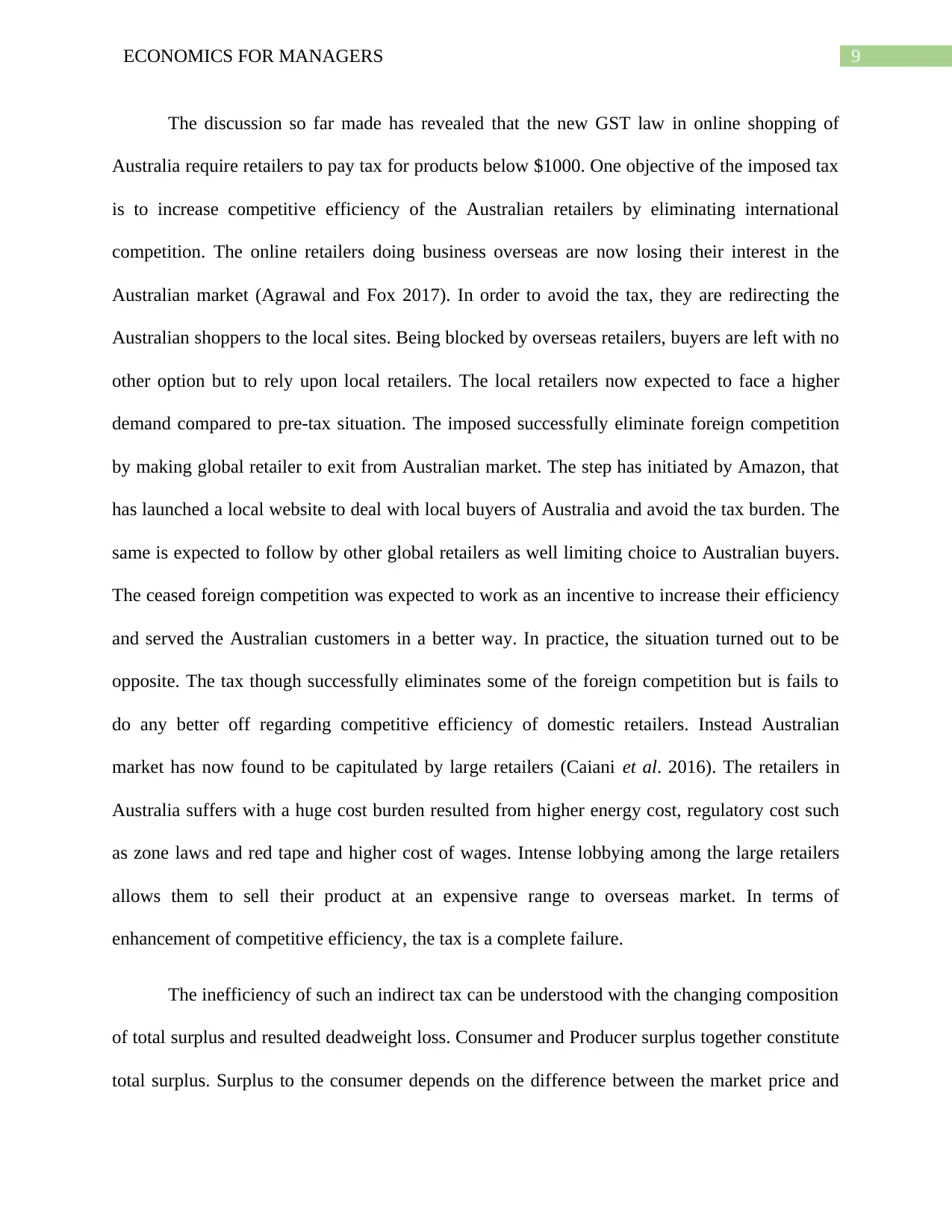
9ECONOMICS FOR MANAGERS
The discussion so far made has revealed that the new GST law in online shopping of
Australia require retailers to pay tax for products below $1000. One objective of the imposed tax
is to increase competitive efficiency of the Australian retailers by eliminating international
competition. The online retailers doing business overseas are now losing their interest in the
Australian market (Agrawal and Fox 2017). In order to avoid the tax, they are redirecting the
Australian shoppers to the local sites. Being blocked by overseas retailers, buyers are left with no
other option but to rely upon local retailers. The local retailers now expected to face a higher
demand compared to pre-tax situation. The imposed successfully eliminate foreign competition
by making global retailer to exit from Australian market. The step has initiated by Amazon, that
has launched a local website to deal with local buyers of Australia and avoid the tax burden. The
same is expected to follow by other global retailers as well limiting choice to Australian buyers.
The ceased foreign competition was expected to work as an incentive to increase their efficiency
and served the Australian customers in a better way. In practice, the situation turned out to be
opposite. The tax though successfully eliminates some of the foreign competition but is fails to
do any better off regarding competitive efficiency of domestic retailers. Instead Australian
market has now found to be capitulated by large retailers (Caiani et al. 2016). The retailers in
Australia suffers with a huge cost burden resulted from higher energy cost, regulatory cost such
as zone laws and red tape and higher cost of wages. Intense lobbying among the large retailers
allows them to sell their product at an expensive range to overseas market. In terms of
enhancement of competitive efficiency, the tax is a complete failure.
The inefficiency of such an indirect tax can be understood with the changing composition
of total surplus and resulted deadweight loss. Consumer and Producer surplus together constitute
total surplus. Surplus to the consumer depends on the difference between the market price and
The discussion so far made has revealed that the new GST law in online shopping of
Australia require retailers to pay tax for products below $1000. One objective of the imposed tax
is to increase competitive efficiency of the Australian retailers by eliminating international
competition. The online retailers doing business overseas are now losing their interest in the
Australian market (Agrawal and Fox 2017). In order to avoid the tax, they are redirecting the
Australian shoppers to the local sites. Being blocked by overseas retailers, buyers are left with no
other option but to rely upon local retailers. The local retailers now expected to face a higher
demand compared to pre-tax situation. The imposed successfully eliminate foreign competition
by making global retailer to exit from Australian market. The step has initiated by Amazon, that
has launched a local website to deal with local buyers of Australia and avoid the tax burden. The
same is expected to follow by other global retailers as well limiting choice to Australian buyers.
The ceased foreign competition was expected to work as an incentive to increase their efficiency
and served the Australian customers in a better way. In practice, the situation turned out to be
opposite. The tax though successfully eliminates some of the foreign competition but is fails to
do any better off regarding competitive efficiency of domestic retailers. Instead Australian
market has now found to be capitulated by large retailers (Caiani et al. 2016). The retailers in
Australia suffers with a huge cost burden resulted from higher energy cost, regulatory cost such
as zone laws and red tape and higher cost of wages. Intense lobbying among the large retailers
allows them to sell their product at an expensive range to overseas market. In terms of
enhancement of competitive efficiency, the tax is a complete failure.
The inefficiency of such an indirect tax can be understood with the changing composition
of total surplus and resulted deadweight loss. Consumer and Producer surplus together constitute
total surplus. Surplus to the consumer depends on the difference between the market price and
Paraphrase This Document
Need a fresh take? Get an instant paraphrase of this document with our AI Paraphraser
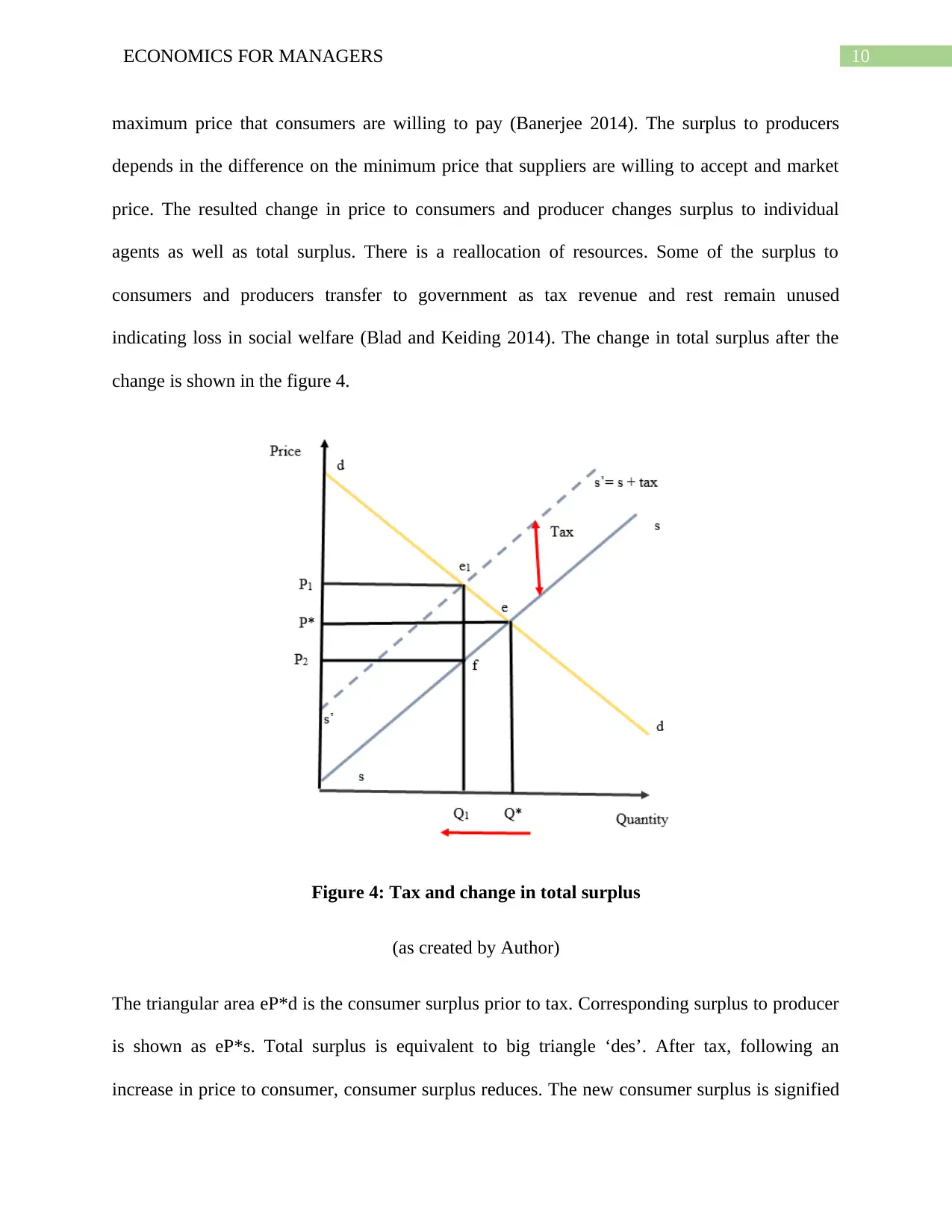
10ECONOMICS FOR MANAGERS
maximum price that consumers are willing to pay (Banerjee 2014). The surplus to producers
depends in the difference on the minimum price that suppliers are willing to accept and market
price. The resulted change in price to consumers and producer changes surplus to individual
agents as well as total surplus. There is a reallocation of resources. Some of the surplus to
consumers and producers transfer to government as tax revenue and rest remain unused
indicating loss in social welfare (Blad and Keiding 2014). The change in total surplus after the
change is shown in the figure 4.
Figure 4: Tax and change in total surplus
(as created by Author)
The triangular area eP*d is the consumer surplus prior to tax. Corresponding surplus to producer
is shown as eP*s. Total surplus is equivalent to big triangle ‘des’. After tax, following an
increase in price to consumer, consumer surplus reduces. The new consumer surplus is signified
maximum price that consumers are willing to pay (Banerjee 2014). The surplus to producers
depends in the difference on the minimum price that suppliers are willing to accept and market
price. The resulted change in price to consumers and producer changes surplus to individual
agents as well as total surplus. There is a reallocation of resources. Some of the surplus to
consumers and producers transfer to government as tax revenue and rest remain unused
indicating loss in social welfare (Blad and Keiding 2014). The change in total surplus after the
change is shown in the figure 4.
Figure 4: Tax and change in total surplus
(as created by Author)
The triangular area eP*d is the consumer surplus prior to tax. Corresponding surplus to producer
is shown as eP*s. Total surplus is equivalent to big triangle ‘des’. After tax, following an
increase in price to consumer, consumer surplus reduces. The new consumer surplus is signified
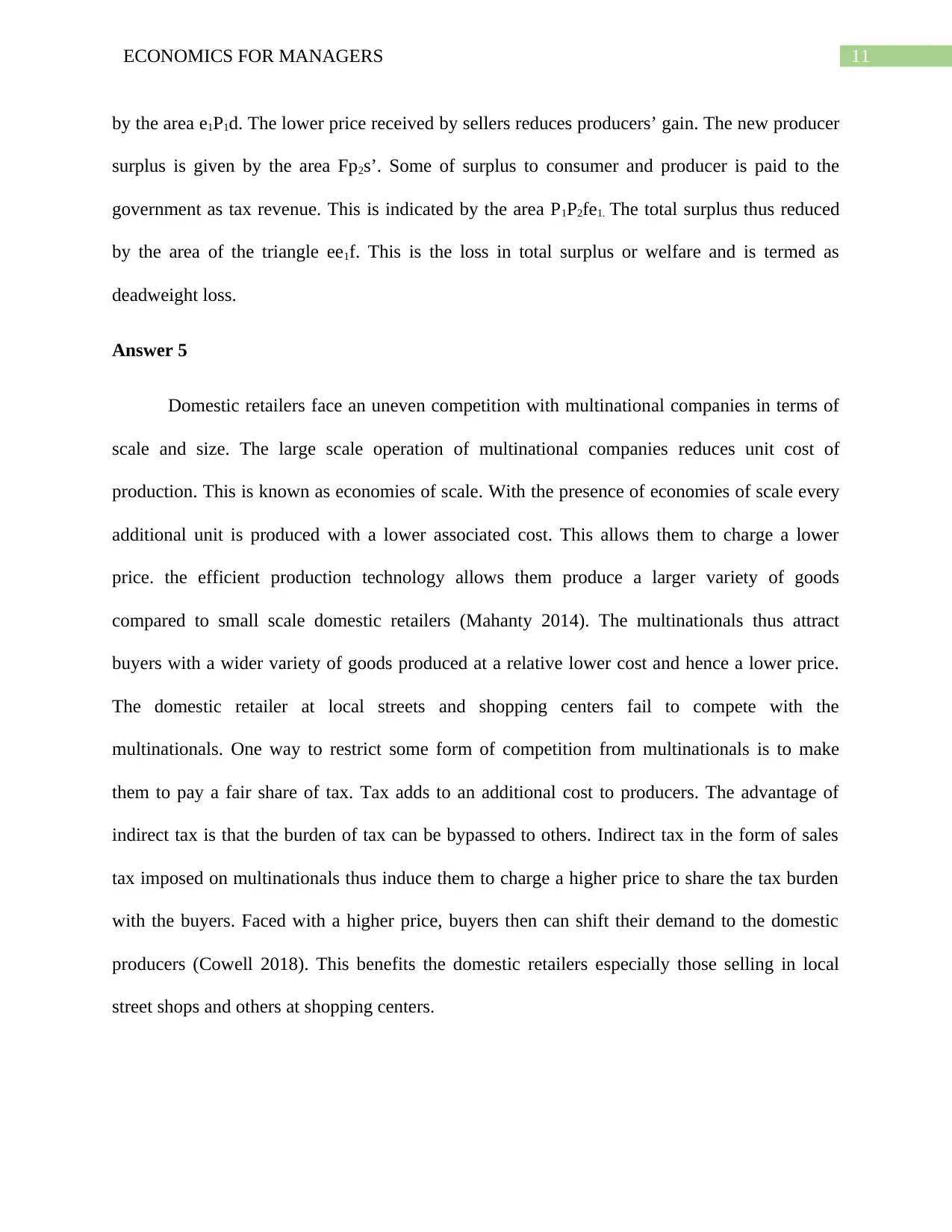
11ECONOMICS FOR MANAGERS
by the area e1P1d. The lower price received by sellers reduces producers’ gain. The new producer
surplus is given by the area Fp2s’. Some of surplus to consumer and producer is paid to the
government as tax revenue. This is indicated by the area P1P2fe1. The total surplus thus reduced
by the area of the triangle ee1f. This is the loss in total surplus or welfare and is termed as
deadweight loss.
Answer 5
Domestic retailers face an uneven competition with multinational companies in terms of
scale and size. The large scale operation of multinational companies reduces unit cost of
production. This is known as economies of scale. With the presence of economies of scale every
additional unit is produced with a lower associated cost. This allows them to charge a lower
price. the efficient production technology allows them produce a larger variety of goods
compared to small scale domestic retailers (Mahanty 2014). The multinationals thus attract
buyers with a wider variety of goods produced at a relative lower cost and hence a lower price.
The domestic retailer at local streets and shopping centers fail to compete with the
multinationals. One way to restrict some form of competition from multinationals is to make
them to pay a fair share of tax. Tax adds to an additional cost to producers. The advantage of
indirect tax is that the burden of tax can be bypassed to others. Indirect tax in the form of sales
tax imposed on multinationals thus induce them to charge a higher price to share the tax burden
with the buyers. Faced with a higher price, buyers then can shift their demand to the domestic
producers (Cowell 2018). This benefits the domestic retailers especially those selling in local
street shops and others at shopping centers.
by the area e1P1d. The lower price received by sellers reduces producers’ gain. The new producer
surplus is given by the area Fp2s’. Some of surplus to consumer and producer is paid to the
government as tax revenue. This is indicated by the area P1P2fe1. The total surplus thus reduced
by the area of the triangle ee1f. This is the loss in total surplus or welfare and is termed as
deadweight loss.
Answer 5
Domestic retailers face an uneven competition with multinational companies in terms of
scale and size. The large scale operation of multinational companies reduces unit cost of
production. This is known as economies of scale. With the presence of economies of scale every
additional unit is produced with a lower associated cost. This allows them to charge a lower
price. the efficient production technology allows them produce a larger variety of goods
compared to small scale domestic retailers (Mahanty 2014). The multinationals thus attract
buyers with a wider variety of goods produced at a relative lower cost and hence a lower price.
The domestic retailer at local streets and shopping centers fail to compete with the
multinationals. One way to restrict some form of competition from multinationals is to make
them to pay a fair share of tax. Tax adds to an additional cost to producers. The advantage of
indirect tax is that the burden of tax can be bypassed to others. Indirect tax in the form of sales
tax imposed on multinationals thus induce them to charge a higher price to share the tax burden
with the buyers. Faced with a higher price, buyers then can shift their demand to the domestic
producers (Cowell 2018). This benefits the domestic retailers especially those selling in local
street shops and others at shopping centers.
⊘ This is a preview!⊘
Do you want full access?
Subscribe today to unlock all pages.

Trusted by 1+ million students worldwide
1 out of 16
Related Documents
Your All-in-One AI-Powered Toolkit for Academic Success.
+13062052269
info@desklib.com
Available 24*7 on WhatsApp / Email
![[object Object]](/_next/static/media/star-bottom.7253800d.svg)
Unlock your academic potential
Copyright © 2020–2026 A2Z Services. All Rights Reserved. Developed and managed by ZUCOL.





